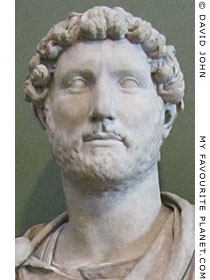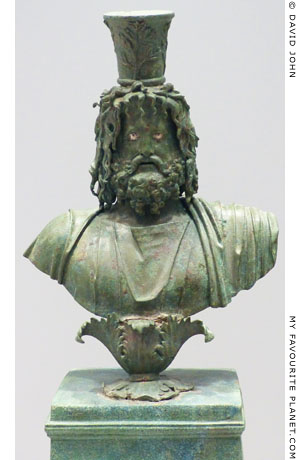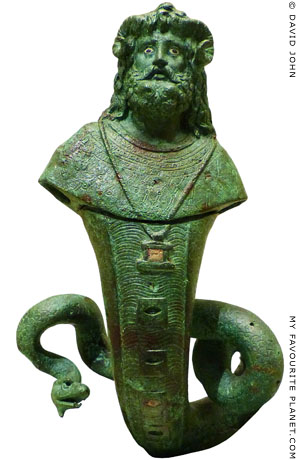The "Red Basilica"
Opening times: daily 8:30 - 17:30
Admission: 5 Turkish lira
The "Red Basilica" (also known as the Red Hall and Red Courtyard, in Turkish Kızıl Avlu), was an enormous Roman temple in the lower city of Pergamon, at the foot of the Acropolis hill. Built in the 2nd century AD, probably during the reign of Emperor Hadrian, it is one of the largest surviving Roman structures of the ancient Greek world.
It is thought that the temple buildings were dedicated to the worship of the Egyptian gods Isis and/or Serapis, and perhaps Osiris, Harpocrates and other deities.
Hadrian is known to have had a special interest in Egyptian religion, and built many temples of Isis and Serapis across the Roman Empire. He even built an Egyptian temple at his villa in Tivoli. He was also wealthy enough to have financed such an expensive building project as this.
The temple stood at the east end of a large walled sacred precinct (temenos), 100 metres wide and 270 metres long (including the temple buildings). The entire temenos was built across the Selinus River (today Bergama Çayı), which was channelled through two parallel tunnels that still run beneath the courtyard. Below the complex there was also a network of underground chambers and passages which connected the temple buildings.
The temenos was entered by a large main marble gateway and two side gates in the west wall, which led to a 200 metre-long open square, probably containing other buildings and monuments. At the eastern end of the square the Great Portico, which had twenty 14 metre-high columns and stretched across the width of the temenos, led to the main temple buildings.
The hall itself was a single space, 26 metres wide and 60 metres long, enclosed by massive red-brick walls, with no interior support or columns. Originally, the walls were clad in marble, and the roof was made of wood. The main entrance was through a doorway with a marble door (which still exists), 7 metres wide, over 14 metres high and weighing more than 30 tons.
The hall was divided into two sections - west and east - by a water channel, 1.4 metres wide and 1.37 metres deep, which was lined with alabaster and ran north-south across the entire width of the building. The eastern side, which could only be entered by priests and their attendants, contained a colossal cult statue of a god, thought to have been at least 10 metres high.
Although it is not known which gods were worshipped here, or the nature of the cult practices, the fact that complex was built over the river and contained so many water features indicates that water played an important role in the beliefs and rituals.
The 13 metre high wall surrounding the temenos suggests that this was a secretive mystery cult whose rites were not to be observed by outsiders. One of the reasons why we know so little about such ancient cults is that their initiates were sworn to secrecy.
The hall was flanked to the north and south by smaller, matching courtyards, surrouned on three sides by stoas, and on the west abutting the back of the Great Portico. Immediately behind (east) each of these courtyards, was a drum-shaped, domed tower, today known as the rotundas, 18 metres high and 12 metres in diameter, which were also clad in marble. The south rotunda was used as part of an olive oil factory in the 19th century. It was restored 2006-2009, and is open to the public as part of the archaeological site. The north rotunda is still used as a mosque, known as the Kurtuluş Camii (see gallery 1, page 30).
Early in the Christian era the temple was destroyed by fire. In the 4th/5th century AD the remains were converted into the Byzantine Church of Saint John. This was later also destroyed, probably in 716–717, during the siege and looting of Pergamon by the Arab general Maslamah ibn Abd al-Malik. Pergamon was conquered in 1336 by the Ottoman Turks, who converted the building into a mosque.
The temenos and temple were excavated from 1927 by the German archaeologist Theodor Wiegand (1864-1936), who also excavated the Asclepieion and discovered the Arsenal of the Pergamon Acropolis. Several other investigation, excavation and restoration works have since been undertaken by the Deutsches Archäologisches Institut (German Archaeological Institute) and Turkish teams of the Bergama Museum.
Continued on next page. |

Emperor Hadrian. Marble bust
from Hadrian's Villa, Tivoli.
British Museum, London. |
| |

Bust of Serapis with Greek and
Egyptian features. 2nd century AD.
Part of the Ambelokipoi hoard
discovered in Athens in 1964.
National Archaeological Museum,
Athens, Greece. Inv. No. 16775. |
| |

Copper alloy statuette of Serapis Amun
Agathodaemon from Egypt. A rare
surviving statue of the syncretic deity.
Late Hellenistic - early Roman period,
1st century BC - 1st century AD.
National Archaeological Museum, Athens,
Greece. Egyptian Collection. Inv. No. 915. |
|